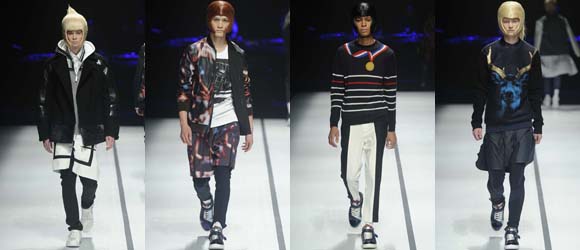Monthly Archives: March 2014
Shantanu Nikhil Show at Wills Lifestyle India Fashion Week AW’14
Rina Dhaka Show at Wills Lifestyle India Fashion Week AW’14
Raakesh Agarwal Show at Wills Lifestyle India Fashion Week AW’14
Kiran Uttam Ghosh Show at Wills Lifestyle India Fashion Week AW’14
Anupama Dayal Show at Wills Lifestyle India Fashion Week AW’14
Burberry HeritageTrench

Originally created to protect officers from wind and rain, the Burberry trench coat named after the trenches where military personnel were stationed, has evolved over 100 years to become an icon, representing timeless British style and design innovation.
The trench coat began as the Burberry Tielocken, patented by Thomas Burberry in 1912. The innovative design featureda beltedclosure without buttons and was made from gabardine, the patented fabric that accompanied explorers on the first expeditions to the poles. Invented by Thomas Burberry in 1879, gabardine revolutionised rainwear.
Woven at the Burberry mill in England, today gabardine is created using many of the traditional techniques that originally set it apart from other fabrics, alongside new, modern finishing processes that make it more water-repellent than ever before. From raw materials to finishing, every step in its production is carefully considered. The cotton is chosen for the fineness and length of its fibres, which give a clean surface texture and enhanced strength.
Made in Castleford, a town in the north of England, by expert workers who combine traditional techniques with modern technological developments, it takes approximately three weeks to make each coat. The Burberry trench coat is presented in three colours taken from the Burberry Heritage Archive – honey, stone and black – and three fits.
Womenswear
- Sandringham slim fit offered in short, mid-length and long
- Kensington modern fit offered in short, mid-length and long
- Westminster classic fit offered in mid-length and long
Menswear
- Sandringham slim fit offered in short and long
- Kensington modern fit offered in short and mid-length
- Wiltshire modern fit with raglan sleeves offered in long
- Westminster classic fit offered in long
Childrenswear
- Sandringham for girls
- Sandringham for boys
Summer Trends in Men’s wear

At the recently concluded Lakmé Fashion Week’s Summer/Resort 2014,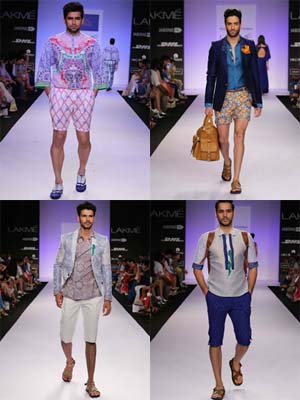 designers Ken Ferns and Kunal Tanna took pant lengths to new heights this season. With shorts being at unusual unique lengths, designers’ didn’t fail to keep the look casual, unique and comfortable.With street style being this year’s theme printed shorts, using floral and light color palettes along with block print capris trended. This summer, go past your jeans and work with wonderful patterns and colors for your shorts.
designers Ken Ferns and Kunal Tanna took pant lengths to new heights this season. With shorts being at unusual unique lengths, designers’ didn’t fail to keep the look casual, unique and comfortable.With street style being this year’s theme printed shorts, using floral and light color palettes along with block print capris trended. This summer, go past your jeans and work with wonderful patterns and colors for your shorts.
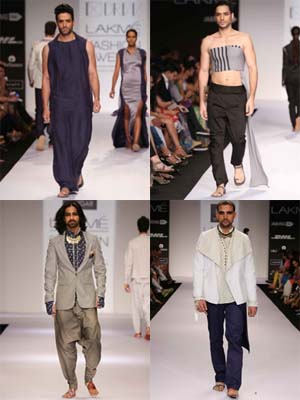 Designer Dhruv Kapur is known for his astute fashion philosophy of being modern, astute, utilitarian, luxurious and sometimes severe. The clothes are functional, minimal, architectural and unisex. His collection this year dwelling on two characteristics of the modern human – duplicity and duality. Transposing these traits onto clothes that lie to the onlooker or serve a dual purpose. Giving an Androgynous feel, designers’ blurred lines and played with the space of men’s and women’s fashion. Floral prints, skirts, feminine collars and colors expressed androgyny is an attempt to move past social conventions.
Designer Dhruv Kapur is known for his astute fashion philosophy of being modern, astute, utilitarian, luxurious and sometimes severe. The clothes are functional, minimal, architectural and unisex. His collection this year dwelling on two characteristics of the modern human – duplicity and duality. Transposing these traits onto clothes that lie to the onlooker or serve a dual purpose. Giving an Androgynous feel, designers’ blurred lines and played with the space of men’s and women’s fashion. Floral prints, skirts, feminine collars and colors expressed androgyny is an attempt to move past social conventions.
Designers have their own theme and inspiration behind their garments, these inspirations help them with the color palette and texture of the garments they make. However, fashion week seemed to sing the blues as designers eleven eleven, Sanjay Hingu, Nitin Chawla and Shyamal & Bhumika all seemed to work with the color blue magnificently. From baby blue to a deep royal tone, the spectrum of blue for men’s fashion came through this season.
garments, these inspirations help them with the color palette and texture of the garments they make. However, fashion week seemed to sing the blues as designers eleven eleven, Sanjay Hingu, Nitin Chawla and Shyamal & Bhumika all seemed to work with the color blue magnificently. From baby blue to a deep royal tone, the spectrum of blue for men’s fashion came through this season.
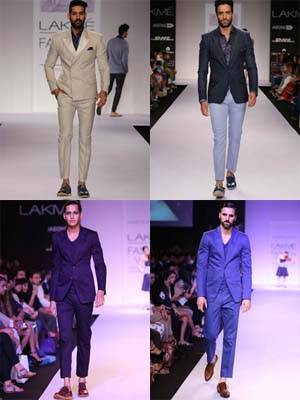 A growing trend that is seen across the fashion world is the sockless effect. When it comes to casuals and semi casual looks, designers opt for a sockless footwear. That trend has been extended to even formal wear. Long gone are men’s suits that cover the length of their leg. A 90 percent length with a visible ankle is highly trendy adding a tad bit of informality to the garment. This accentuates the formal shoes that are either worn sockless or with ankle socks. Designers Nitin Chawla and Narendra Kumarshowcased a wonderful array of men’s suits with this very trend.
A growing trend that is seen across the fashion world is the sockless effect. When it comes to casuals and semi casual looks, designers opt for a sockless footwear. That trend has been extended to even formal wear. Long gone are men’s suits that cover the length of their leg. A 90 percent length with a visible ankle is highly trendy adding a tad bit of informality to the garment. This accentuates the formal shoes that are either worn sockless or with ankle socks. Designers Nitin Chawla and Narendra Kumarshowcased a wonderful array of men’s suits with this very trend.
Mawi Keivom

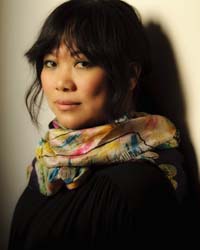 Mawi along with Tim Awan launched their internationally acclaimed accessory brand called ‘MAWI’. Mawi graduated in Fashion Designing from Auckland Institute of Technology and spent her formative years in New York. She then moved to London where she got acquainted to Tim and concluded ‘MAWI’.
Mawi along with Tim Awan launched their internationally acclaimed accessory brand called ‘MAWI’. Mawi graduated in Fashion Designing from Auckland Institute of Technology and spent her formative years in New York. She then moved to London where she got acquainted to Tim and concluded ‘MAWI’.
Her early years of experiences include her accessory collection being showcased in the London Fashion Week 2002. Thereafter, she won the prestigious New Generation Award by the British Fashion Council for 3 consecutive seasons. Her other achievements include her winning the Mayor of the Hackney’s Best Product Design Award in 2009. She was further selected as the future luxury leader by Walpole British Luxury Brands of Tomorrow programme in 2010. She made it to the Professional Jeweller Hot 100 list in 2012.
Furthermore, Mawi and Tim were appointed on the judging panel of the jewellery category of the International Talent Support Awards (ITS) sponsored by Swarosvki ELEMENTS and Swatch. Among her other experiences in the fashion arena, she was invited to collaborate with some of the world’s most iconic labels and top fashion houses, including Disney Couture, Atelier Swarovski, Hugo Boss, Swarovski Crystallized, Bruno Magli and Selfridges.
The designer marked her entry in India by participating in Lakme Fashion Week Summer Resort 2014 with the designer Gaurav Gupta. However, she retails her entire accessory collection through her store at Somerset House in London and in Porto Montenegro.
You can get Mawi Keivom at:
www.mawi.co.uk
Yoshio Kubo Men’s RTW Fall 2014
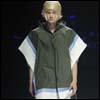
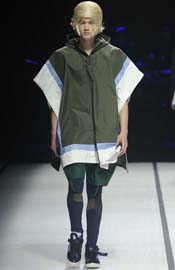 Known for his edgy and wacky collections, this season at Tokyo Fashion week Yoshio Kubo featured a series of helmet like wigs in styles including Mohawks, dreadlocks and braids.
Known for his edgy and wacky collections, this season at Tokyo Fashion week Yoshio Kubo featured a series of helmet like wigs in styles including Mohawks, dreadlocks and braids.
The majority of the looks were casual and street-ready, with pieces such as oversize rain ponchos, blouson jackets and tops in abstract and geometric prints, and puffer vests and toggle coats trimmed in bright aqua fur.
